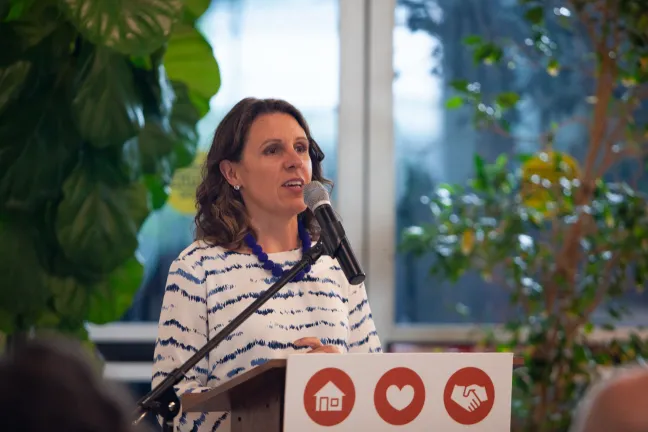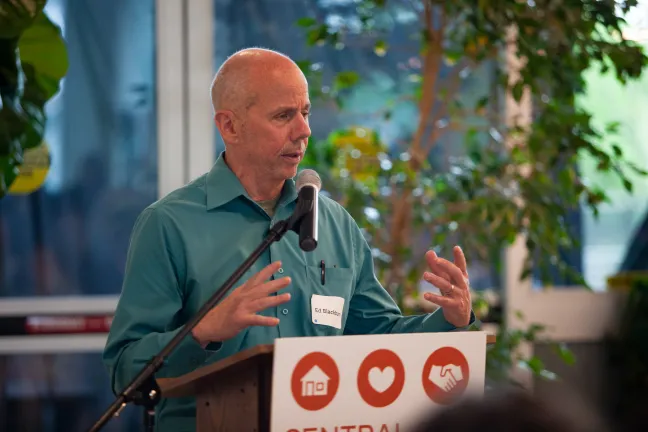Housing plus services is the solution to chronic homelessness.
That was the message on Tuesday, July 9, as leaders celebrated the opening of Central City Concern’s Blackburn Center, a six-story building on East Burnside featuring primary care, a pharmacy, recovery and mental health services, and more than 175 beds — all under one roof.
The east Portland health and housing complex is named for Central City Concern’s longtime former director, Ed Blackburn. It features 51 units of respite care transitional housing, 10 units of palliative care housing, 80 transitional, low-income single room-occupancy units, and 34 studios of permanent housing for people in recovery. More than 3,000 clients will be served annually by the on-site clinic.
Tuesday’s ceremony featured a massive speaker list including Chair Deborah Kafoury, Portland Mayor Ted Wheeler, Metro Councilor Shirley Craddick, and leaders from Central City Concern, Adventist Health, CareOregon, Kaiser Permanente, Providence, Legacy Health, and Oregon Health & Sciences University.
Dr. Rachel Solotaroff, Central City Concern’s president and chief executive, described the Blackburn Center as a critical investment in east Portland — an area with a growing need for transitional housing and recovery programs as gentrification in the central city pushes poverty east.
“The needs in east Portland as well as the enthusiasm of community partners and CCC staff and community was irreplicable,” Solotaroff said. “The Blackburn Center, in its fully realized form, not only anticipates, but then matches the needs of east Portland’s individuals, particularly those experiencing homelessness, seamlessly addressing the physical, behavioral, social and spiritual aspects of each person.”
The combination of housing and health services is part of a growing trend. Other developments offering a similar model include an Asian Health & Family Services project in Lents and Cascadia’s Garlington Campus in Northeast Portland. The goal is creating communities where people experiencing complex challenges can thrive together.
Those programs, Chair Kafoury said, are leading the way in Multnomah County’s push to end homelessness.
“‘Housing is health’ is no longer just an idea or a catchphrase,” Chair Kafoury said. “It is fast becoming a reality. It isn’t just the right thing to do, it is also the most effective thing to end people’s homelessness.”
Julie Smith, a former Central City Concern client who achieved sobriety after years of addiction to heroin and alcohol, said she struggled until she found the kind of community support Central City Concern’s model provides. At her lowest point, her children were taken away from her. She told herself she didn’t want to live anymore.
“I lost everything — my job, my kids, my home,” Smith said. “Let me tell you, there is no worse feeling than having the police take your children from you because you can’t take care of them. It was the worst feeling but, then again, the drugs meant more to me at that time.”
After getting into a Central City Concern recovery program, things started to change. She got treatment, training and support. Now, she says, she has things to live for. As a construction apprentice, she even worked on the Blackburn Center, helping to build rooms just like the one that she stayed in during her recovery.
“It’s super meaningful to me,” she said. “It really hits home when I see the beds coming in, because I remember sleeping in those beds every night. And I remember the feeling of finally having a safe place to sleep, surrounded by a supportive community. I’m really proud to be part of the Blackburn Center, from the ground up.”
The Blackburn Center’s namesake — Ed Blackburn — was in attendance for the ceremony. Blackburn, Central City Concern’s retired executive director, worked his way up through 25 years at the agency. When he started, Central City Concern had just 80 employees. Now, it has more than 800, with an annual operating budget of $60 million, while serving more than 13,000 people each year.
Blackburn, the last person to speak Tuesday, described himself as an introvert who prefers to stay out of the limelight. When he found out the building would be named after him, he cringed.
But after some reflection, he agreed on one premise: that it would lay the groundwork for other projects that help in people’s recovery.
“If my name helps inspires people to do more — because this building is not the end, hopefully it’s a torch that lights the way to even more collaborations and more investments for the purpose of healing our community — then I have to say I’m so honored to have my name on this building.”



